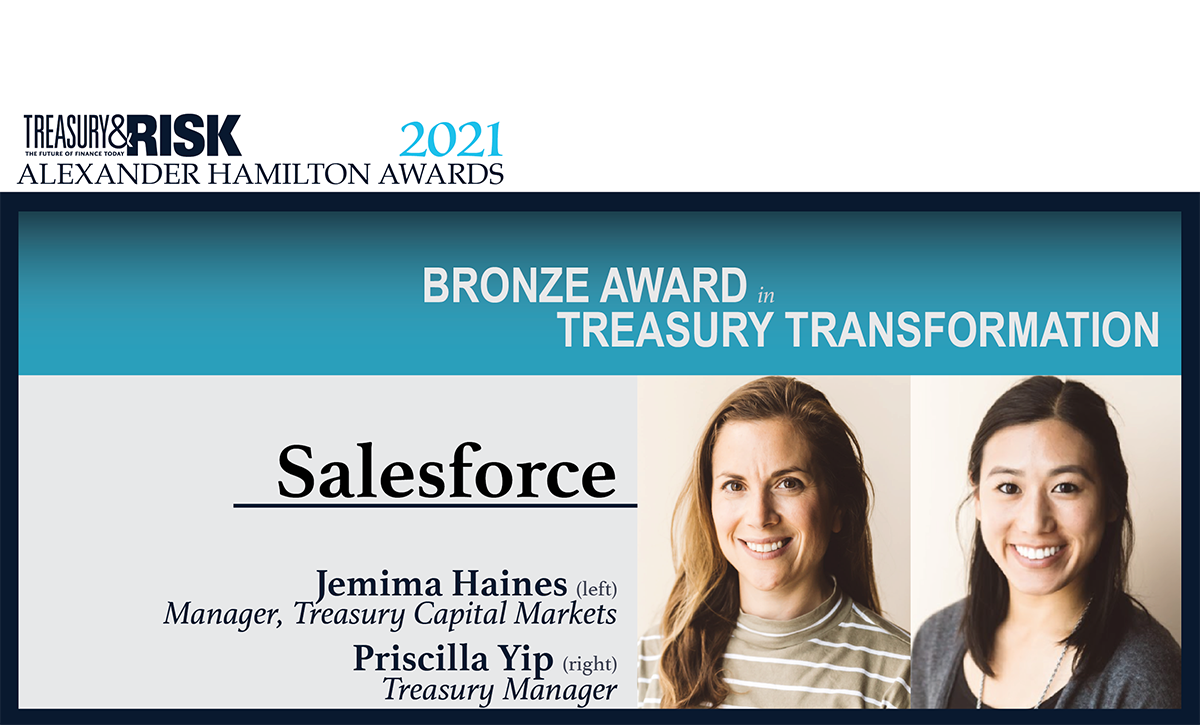
The treasury team at Salesforce takes pride in the sophistication of their cash forecasting model. They work closely with groups throughout the company—including finance-and-strategy, mergers and acquisitions finance (M&A), marketing, and real estate teams—to forecast cash flows so that the company can optimally meet its liquidity needs.
"Our treasury management system provides real-time visibility into all our global transactions and bank accounts," says Jemima Haines, manager of treasury capital markets for Salesforce. "Then, on a monthly basis, we forecast cash flows for that month, for the quarter, and for the year. And at the end of the month, we perform a variance analysis to actuals."
Recommended For You
Accurate forecasting is crucial. "Salesforce has experienced exponential growth over the past decade," explains treasury manager Priscilla Yip. "Our cash forecasts give us the visibility we need to support this growth. We can make better decisions around both putting our cash to work and investing excess cash balances."
Still, until recently, a team outside of treasury was forecasting company invoicing, importing data from other internal systems into Excel for analysis. As Salesforce grew, managing the spreadsheets became painstakingly slow and time-consuming.
"The process was working, but we could see that Excel didn't have the capacity to support the level of growth we expected within the next two years," Haines says. "In addition, because of competing priorities, the group putting this forecast together was not able to provide it to treasury as early in the month as we wanted it. And when we needed additional details or a variance analysis, having to turn to another team for that information created a delay."
In short, the treasury team saw an opportunity to substantially improve companywide invoicing forecasting. Treasury advocated to take ownership of the forecasting model and to overhaul the associated processes, streamlining and automating workflows to reduce the amount of manual work required. "It naturally makes sense for the treasury team to own the invoicing forecast, because we're the end users of the forecast and it's an input into our business-critical cash flow forecasts," Yip points out.
The treasury group hosted a series of workshops with the various internal teams that contribute to the forecasting model. As project manager, Yip leveraged Salesforce's business process innovation framework to diagnose the challenges, find process bottlenecks and redundancies, and prioritize teams' needs and objectives.
"The needs assessment identified several goals for the project," Yip says. "In addition to moving responsibility into treasury, we wanted to move away from Excel and onto a technology platform that would be more scalable. We wanted to introduce automation wherever possible so that we would have more time to analyze the numbers versus manually putting together forecasts. And we wanted to minimize the length of time it takes to create each forecast so that it can feed into our overarching cash flow forecast earlier each month."
 The project team re-engineered the invoicing forecasting model, consolidating certain components across similar product categories in order to reduce complexity. "When you build a process that then grows over time, it's really valuable to take a step back and re-examine whether you're doing it in the best possible way," says Haines.
The project team re-engineered the invoicing forecasting model, consolidating certain components across similar product categories in order to reduce complexity. "When you build a process that then grows over time, it's really valuable to take a step back and re-examine whether you're doing it in the best possible way," says Haines.
Yip sees this type of process analysis as a key differentiator of the initiative. "One of my biggest lessons learned from this entire project is the importance of breaking down a complex process into its smallest pieces," she says. "That enables you to fully understand what's going on. Then you can put those pieces back together in a way that automates and streamlines them."
On top of redesigning the model for forecasting invoice collections, the team replaced Excel with software built to streamline these processes. Data flows automatically into the new tool, greatly reducing the tedious manual work required of the forecasting team. "We're a technology company, so it makes sense for us to optimize our processes by using purpose-built software," Haines says.
Invoicing forecasts are now available six days earlier each month than they were previously, and creating them takes less than half as much staff time. Moreover, Salesforce treasury improved the forecasts' accuracy by minimizing human touchpoints. Perhaps the greatest benefit of bringing the forecasts under the treasury umbrella is the dramatic improvement in invoicing visibility.
"Before, we received this forecast only as another team's output," Haines says. "Because we are the ones actually creating it now, we have a much better understanding of all the different inputs and drivers. That's incredibly powerful."
Having ownership of the invoicing forecasting process also enables treasury staff to perform their own variance analyses. "When you forecast, you also want to reconcile back to actuals," Haines says. "Previously, we found this process to be more lengthy than it needed to be. Instead of figuring out the causes of any discrepancy ourselves, we had to go to another team. Now, we're able to just do the variance analysis ourselves."
These analyses have improved the team's cash flow forecasting accuracy. And the overall efficiency improvement resulting from the initiative has freed up treasury for more value-added activities.
"There are two ways to view a treasury team," Haines says. "On the one hand, you can just view us as counting the pennies and managing transactions. Obviously, that is important—but there's also the potential within treasury to be much more strategic. This project has enabled us to provide more insights and do more analysis. And honestly, that is where we feel we can provide the most value."
Getting to that point requires treasury teams to think outside their narrow box, even if they feel short-staffed and overburdened. "Oftentimes, when we're doing our day-to-day jobs, it's easy to get overly comfortable in the routine," Yip says. "But treasury managers need to always be ready to say 'yes' to projects that will add real value in the long term. Taking on these initiatives may mean extra work, but it also presents valuable growth opportunities. Treasury needs to prioritize these types of projects alongside all our other responsibilities."
See also:
- Increasing Treasury's Bandwidth by Harnessing Accessible Tech
- Efficient Access Management for Bank Portals Around the World
- Cash Visibility That Supports Global Growth
- On-demand webcast celebrating our four winning projects: Treasury Transformation: Get the Keys to Success
And join Treasury & Risk for a webcast celebrating the winners of our 2021 Alexander Hamilton Awards in Working Capital Management: Partner Impact! The live virtual event will take place on May 5 at 12pmET. Register today.

© Touchpoint Markets, All Rights Reserved. Request academic re-use from www.copyright.com. All other uses, submit a request to [email protected]. For more inforrmation visit Asset & Logo Licensing.



